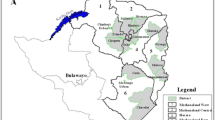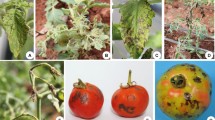Abstract
A tospovirus isolated from naturally infected cineraria plants in commercial greenhouses in Shiraz, Iran, induced rings and chlorotic and necrotic spots on leaves, growth reduction and death of the plants. The viruswas transmitted by three populations of Thrips tabaci. Antisera were produced against purified virions and viral nucleocapsids and used to study the virus host range and relationships. On the basis of enzyme-linked immunosorbent assay, tomato, anemone, Arum sp., dandelion and pepper were natural hosts of the virus. SDS-PAGE revealed three major structural proteins corresponding to the Tospovirus N, G1 and G2 proteins. Three RNA segments were resolved in a 1% agarose gel with molecular masses of 1.02×106 Da, 1.87×106 Da and 2.86×106 Da, corresponding to the virus S, M and L RNAs, respectively. No serological relationships were detected between the cineraria virus and Tomato spotted wilt virus, Tomato chlorotic spot virus and Groundnut ring spot virus using the virus nucleocapsid IgG in dot immunobinding assays. Further characterisation by nucleotide sequencing of the virus N gene revealed that it was a strain of Tomato yellow ring virus, although the cineraria isolate appears to have a different experimental host range compared to tomato isolates of the virus.
Similar content being viewed by others
References
de Ávila AC, de Haan P, Kormelink R, Resende RO, Goldbach RW, Peters D (1993a) Classification of tospoviruses based on phylogeny of nucleoprotein gene sequences. The Journal of General Virology 74, 153–159.
de Ávila AC, de Haan P, Smeets MLL, Resende RO, Kormelink R, Kitajima EW, Goldbach RW, Peters D (1993b) Distinct levels of relationships between tospovirus isolates. Archives of Virology 128, 211–227. doi: 10.1007/BF01309435
Avrameas S (1969) Coupling of enzymes to proteins with glutaraldehyde and use of conjugate for the detection of antigens and antibodies. Immunochemistry 6, 43–52. doi: 10.1016/0019-2791(69)90177-3
Ball E, Hampton R, De Boer S, Schaad N (1990) Polyclonal antibodies. In ‘Serological methods for detection and identification of viral and bacterial plant pathogens’. (Eds R Hampton, E Ball, S De Boer) (APS Press: St Paul, MN)
Bananej K, Shahraeen N, Ahoonmanesh A, Lesemann DE, Shahriary D (1998) Identification of tomato spotted wilt virus from tomato fields in Varamin area. Iranian Journal of Plant Pathology 34, 107–116.
Best RJ, Palk BA (1964) Electron microscopy of strain E of Tomato spotted wilt virus and comments on its probable biosynthesis. Virology 23, 445–460. doi: 10.1016/0042-6822(64)90229-6
Black LM, Brakke MK, Vatter AE (1963) Purification and electron microscopy of Tomato spotted wilt virus. Virology 20, 120–130. doi: 10.1016/0042-6822(63)90146-6
Chu FH, Chao CH, Peng YC, Lin SS, Chen CC, Yeh SD (2001) Serological and molecular characterization of Peanut chlorotic fan-spot virus, a new species of the genus tospovirus. Phytopathology 91, 856–863.
Clark MF, Adams AN (1977) Characteristics of the microplate method of enzyme linked immunosorbent assay for the detection of plant viruses. The Journal of General Virology 34, 475–483.
Clark MF, Bar-Joseph M (1984) Enzyme immunosorbent assay in plant virology. In ‘Methods in virology. Vol VII’. (Eds K Maramorosh, H Koprowski) pp. 51–85. (Academic Press: New York)
Cortês I, Livaratos IC, Derks A, Peters D, Kormelink R (1998) Molecular and serological characterization of Iris yellow spot virus, a new and distinct tospovirus species. Phytopathology 88, 1276–1282.
Froussard P (1992) Arandom PCR method (rPCR) to constructwhole cDNA library from low amounts of RNA. Nucleic Acids Research 20, 2900. doi: 10.1093/nar/20.11.2900
Ghotbi T, Shahraeen N, Winter S (2005) Occurrence of tospoviruses in ornamental and weed species in Markazi and Tehran Provinces in Iran. Plant Disease 89, 425–429.
Golnaraghi AR, Shahraeen N, Pourrahim R, Ghorbani Sh, Farzadfar Sh (2001) First report of Groundnut bud necrosis virus in Iran. Plant Disease 85, 1286.
Gonsalves D, Trujillo EE (1986) Tomato spotted wilt virus in papaya and detection of the virus by ELISA. Plant Disease 70, 501–506.
Gumpf DG, Weathers LG (1972) Identification and purification of Tomato spotted wilt virus isolated from ageratum. Plant Disease Reporter 56, 869–872.
Hassani-Mehraban A, Saaijer J, Peters D, Goldbach R, Kormelink R (2005) A new tomato-infecting tospovirus from Iran. Phytopathology 95, 852–858.
Hsu HT, Lawson RH (1991) Direct tissue blotting for detection of Tomato spotted wilt virus in impatiens. Plant Disease 75, 292–295.
Laemmli UK (1970) Cleavage of structural proteins during the assembly of head of bacteriophage T4. Nature 227, 680–685. doi: 10.1038/227680a0
Moeini AA, Izadpanah K (2002) Report of Impatiens necrotic spot virus infection of tobacco in Iran. In ‘Proceedings of 15th Iranian plant protection congress, Kermanshah, Iran’. p. 130.
Moeini AA, Sahandpour A, Izadpanah K (1998) Identification of Tomato spotted wilt virus (TSWV) in ornamental plants and tomato in Shiraz. In ‘Proceedings of 13th Iranian plant protection congress, Karaj, Iran’. p. 199.
Mohamed NA, Randles JW, Francki RIB (1973) Protein composition of tomato spotted wilt virus. Virology 56, 12–21. doi: 10.1016/0042-6822(73)90283-3
Mound LA (1996) The Thysanoptera vector species of tospoviruses. Proceedings of 3rd international symposium on tospoviruses and thrips in flora and vegetable crops. Acta Horticulture 431, 298–307.
Mumford RA, Barker I, Wood KR (1994) The detection of tomato spotted wilt virus using the polymerase chain reaction. Journal of Virological Methods 46, 303–311. doi: 10.1016/0166-0934(94)90002-7
Paliwal YC (1973) Some properties and thrips transmission of Tomato spotted wilt virus in Canada. Canadian Journal of Botany 52, 1177–1182.
Rasoulpour R, Izadpanah K (2003a) Identity and host range of a tospovirus naturally infecting cineraria in Fars. In ‘Proceedings of 16th Iranian plant protection congress, Tabriz, Iran’. p. 452.
Rasoulpour R, Izadpanah K (2003b) Transmission of cineraria isolate of Tomato spotted wilt virus by onion thrips in Shiraz. Iranian Journal of Plant Pathology 39, 28–29.
Rasoulpour R, Izadpanah K (2004) Purification and characterization of cineraria isolate of Tomato spotted wilt virus. In ‘Proceedings of 2nd Iranian virology congress’. p. 366.
Roberts CA, Dietzgen RG, Heelan LA, Maclean DJ (2000) Real-time RT-PCR fluorescent detection of Tomato spotted wilt virus. Journal of Virological Methods 88, 1–8. doi: 10.1016/S0166-0934(00)00156-7
Roggero P, Melani W, Ciuffu M, Tavella L, Tedeschi R, Stravato VM (1999) Two field isolates of Tomato spotted wilt tospovirus overcome the hypersensitive response of a pepper (Capsicum annuum) hybrid with resistance introgressed from C. chinense PI152225. Plant Disease 83, 965.
Roggero P, Masenga V, Tavella L (2002) Field isolates of Tomato spotted wilt virus overcoming resistance in pepper and their spread to other host in Italy. Plant Disease 86, 950–954.
Satyanarayana T, Mitchell SE, Reddy DVR, Brown S, Kresovich S, Jarret R, Gowda S, Naidu RA, Demski JW (1996) Peanut bud necrosis virus: purification of nucleocapsids and sequence homology of nucleocapsid protein and glycoprotein precursor with other tospoviruses. Proceedings of 3rd international symposium on tospoviruses and thrips in flora and vegetable crops. Acta Horticulture 431, 228–236.
Shahraeen N, Ghotbi T, Mehraban AH (2002) Occurrence of Impatiens necrotic spot virus in ornamentals in Mahallat and Tehran provinces in Iran. Plant Disease 86, 694.
Weekes R, Barker I, Wood KR (1996) An RT-PCR test for the detection of Tomato spotted wilt tospovirus incorporating immunocapture and colorimetric estimation. Journal of Phytopathology 144, 575–580.
Weekes RJ, Barker I, Spence NJ, O’Neill T, Wood KR (1998) AUK isolate of impatiens necrotic spot virus from glasshouse-grown cineraria. Journal of Phytopathology 146, 201–203.
Whitfield AE, Ullman DE, German TL (2005) Tospovirus-thrips interactions. Annual Review of Phytopathology 43, 459–489. doi: 10.1146/annurev.phyto.43.040204.140017
Wijkamp I, Goldbach R, Peters D (1996) Differential susceptibilities between leaf disks and plants in the transmission of Tomato spotted wilt virus by Frankliniella occidentalis to TSWV hosts and transgenic plants. Journal of Phytopathology 144, 355–362.
Winter S, Shahraeen N, Koerbler M, Lesemann D-E (2006) Characterization of Tomato fruit yellow ring virus: a new tospovirus species infecting tomato in Iran. Plant Pathology 55, 287. doi: 10.1111/j.1365-3059.2005.01263.x
Yeh SD, Chao CH, Cheng YH, Chen CC (1996) Serological comparison of four distinct tospoviruses by polyclonal antibodies to purified nucleocapsid proteins. Proceedings of 3rd international symposium on tospoviruses and thrips in flora and vegetable crops. Acta Hortculture 431, 122–134.
Author information
Authors and Affiliations
Corresponding author
Rights and permissions
About this article
Cite this article
Rasoulpour, R., Izadpanah, K. Characterisation of cineraria strain of Tomato yellow ring virus from Iran. Australasian Plant Pathology 36, 286–294 (2007). https://doi.org/10.1071/AP07023
Received:
Accepted:
Issue Date:
DOI: https://doi.org/10.1071/AP07023




